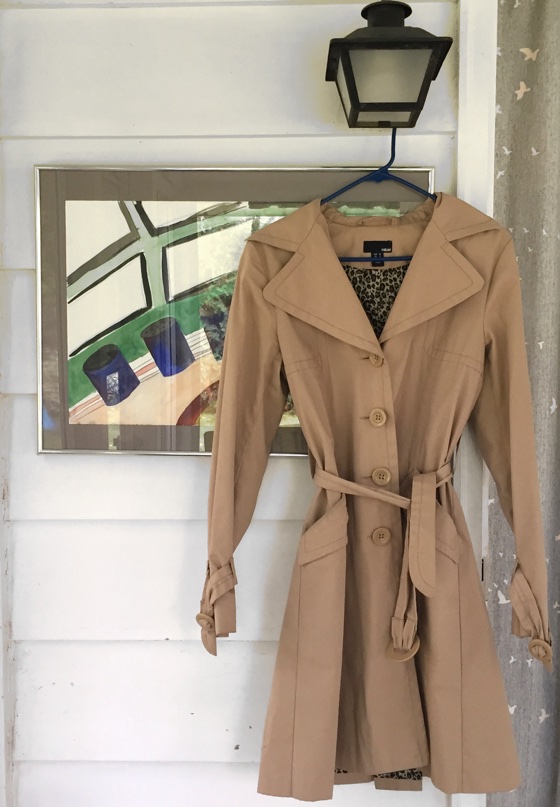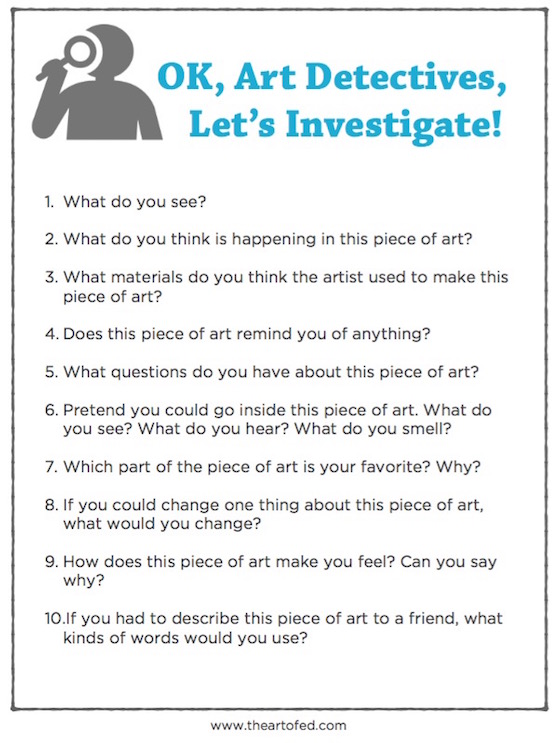We all know that Critical Thinking is a vital 21st Century Skill for our students. However, sometimes it’s difficult to think about presenting the concept to very young students. The good news is that with a little imagination, anything is possible. Today I’m sharing a simple activity you can use with your youngest students to begin to develop their critical thinkings skills.
The activity is called Art Detective and is super simple to pull off.
It would be perfect for an introduction to a project or theme, or an excellent option to pull out when you have 15 extra minutes of class. Here’s how to do it.
Help your students become art detectives.
1. Get into costume.

This step is optional, but it makes for a more dramatic experience for the students. If you already own a trench coat, great! If not, head to your nearest thrift store to pick one up for a few bucks. While the trench is the key piece, there’s no one stopping you from going all out with a hat, sunglasses, and a magnifying glass.
2. Choose a piece of art for students to “investigate.”
If you’re using this as an introduction to a project or theme, you may want to use a specific piece of art. Most likely, your choice will only be available in poster form. However, if you’re doing this activity outside of a specific project, why not bring in a real, physical piece of art? This could be a painting you’ve done (don’t tell them!), a piece of work done by a high school student in your district, or something you have hanging in your home. There is something about a real piece of art that truly engages students. In addition, don’t feel as though you have to limit your choices to 2D works. Ceramic pieces, sculptures, weavings, and artifacts also all work well. In fact, if you don’t know anything about the piece yourself, it can lead to a much more authentic discussion.
3. Set the stage.
Explain the premise of the activity: You have just discovered the piece of art you are holding (or showing) and you have no idea what it is or what it’s about. You need the students help to figure it out!
4. Guide the discussion without judgment.
As art teachers, part of our job is to know a lot about art. However, take a minute to think of this activity from the students’ perspective. They may have never seen anything like what you’re showing them. They may be looking at a real piece of pottery for the first time ever. This is a magical experience! Using the questions from the handout below, guide the students through an organic discussion led by their ideas and reactions.

If students are coming to different conclusions than the artist or different conclusions than you, it’s OK! Ask follow-up questions to reveal their thought processes. “What makes you think the person feels angry?” or “What about the picture makes you think it was made with fabric?” are two examples of these types of questions. I guarantee you will be blown away by their ideas and insights.
The beauty of this activity is that just by participating, students are developing critical thinking skills. The NEA has a helpful document available for download called “An Educator’s Guide to the ‘Four Cs’” which details how part of critical thinking is making judgments and decisions. Specifically, students should develop skills to “Effectively analyze and evaluate evidence, arguments, claims, and beliefs,” and, “Interpret information and draw conclusions based on the best analysis,” and finally, “Identify and ask significant questions that clarify various points of view and lead to better solutions.”
Over time, providing your students with opportunities like playing Art Detectives will do just that! For even more insight into helping students analyze art, check out the following articles and lesson plan.
- Slow Looking and 5 Other Simple Activities to Enhance Your Students’ Ability to Analyze Art
- Five Easy Steps for Talking with Children About Art (via Tinkerlab)
- Artists Analyze: Free Lesson Plan Download
How do you get young students to begin to think about artwork in a critical way?
Do you have any favorite art pieces for them to analyze?
Magazine articles and podcasts are opinions of professional education contributors and do not necessarily represent the position of the Art of Education University (AOEU) or its academic offerings. Contributors use terms in the way they are most often talked about in the scope of their educational experiences.




